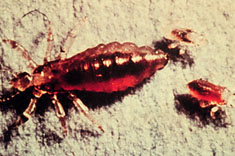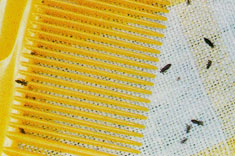Head lice, also called pediculus humanus capitis (peh-dick'-you-lus hue'-man-us cap'-ih-tus'), are parasitic insects found on the heads of people.
Who is at risk for getting head lice?
Anyone who comes in close contact with someone who already has head lice, contaminated clothing, and other belongings. Preschool and elementary-age children, 3-10, and their families are infested most often. Girls get head lice more often than boys, women more than men. In the United States, African-Americans rarely get head lice.
How did my child get head lice?
- By contact with an already infested person. Contact is common during play at school and at home (slumber parties, sports activities, at camp, on a playground).
- By wearing infested clothing, such as hats, scarves, coats, sports uniforms, or hair ribbons.
- By using infested combs, brushes, or towels.
- By lying on a bed, couch, pillow, carpet, or stuffed animal that has recently been in contact with an infested person.
 What do head lice look like?
What do head lice look like?
There are three forms of lice: the nit, the nymph, and the adult.
- Nit: Nits are head lice eggs. They are hard to see and are often confused for dandruff or hair spray droplets. Nits are found firmly attached to the hair shaft. They are oval and usually yellow to white. Nits take about 1 week to hatch.
- Nymph: The nit hatches into a baby louse called a nymph. It looks like an adult head louse, but is smaller. Nymphs mature into adults about 7 days after hatching. To live, the nymph must feed on blood.
- Adult: The adult louse is about the size of a sesame seed, has six legs, and is tan to grayish-white. In persons with dark hair, the adult louse will look darker. Females lay nits; they are usually larger than males. Adult lice can live up to 30 days on a person's head. To live, adult lice need to feed on blood. If the louse falls off a person, it dies within 2 days.
 Where are head lice most commonly found?
Where are head lice most commonly found?
On the scalp behind the ears and near the neckline at the back of the neck.
Head lice hold onto hair with hook-like claws found at the end of each of their six legs. Head lice are rarely found on the body, eyelashes, or eyebrows.
What are the signs and symptoms of head lice infestation?
- Tickling feeling of something moving in the hair.
- Itching, caused by the an allergic reaction to the bites.
- Irritability
- Sores on the head caused by scratching. These sores can sometimes become infected.
How is head lice infestation diagnosed?
By looking closely through the hair and scalp for nits, nymphs, or adults. Finding a nymph or adult may be difficult; there are usually few of them and they can move quickly from searching fingers. If crawling lice are not seen, finding nits within a 1/4 inch of the scalp confirms that a person is infested and should be treated. If you only find nits more than 1/4 inch from the scalp, the infestation is probably an old one and does not need to be treated. If you are not sure if a person has head lice, the diagnosis should be made by a health care provider, school nurse, or a professional from the local health department or agricultural extension service.
- Treating head lice (CDC)
- About Head Lice (NYSDOH)
- Guía Rápida para Eliminar los Piojos Eficientemente (Lancaster County)
Health Advisory
